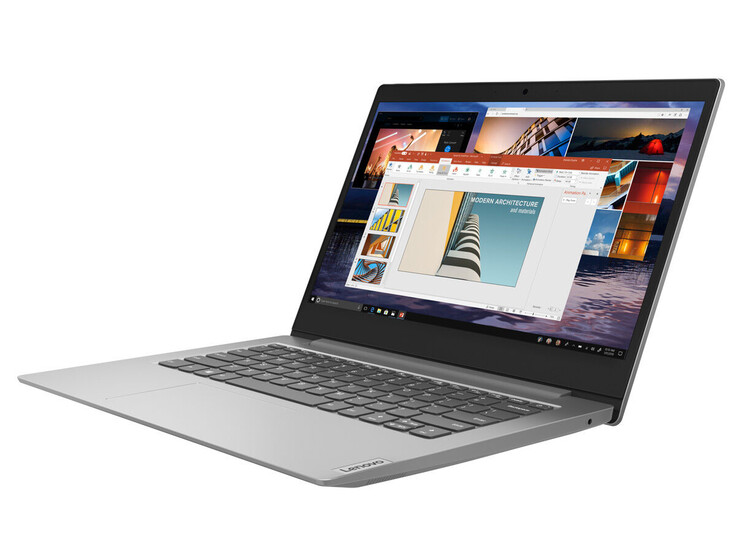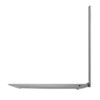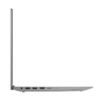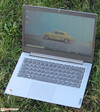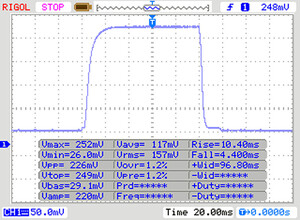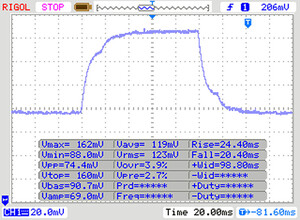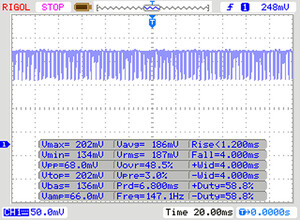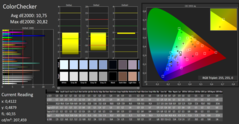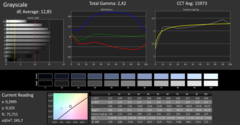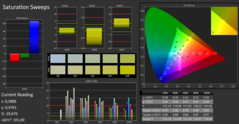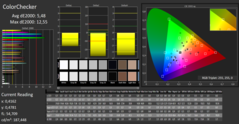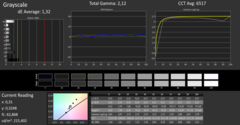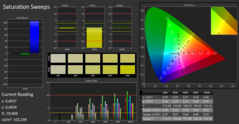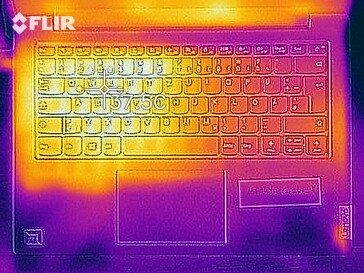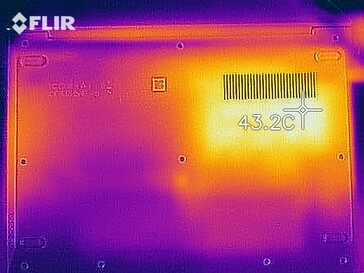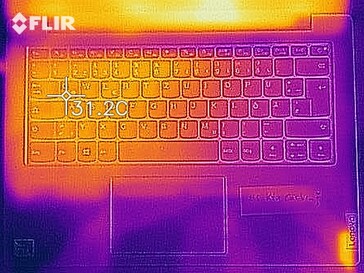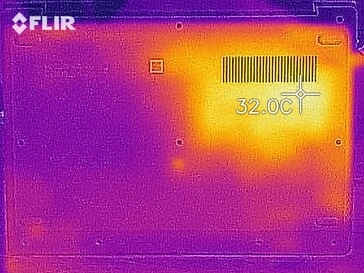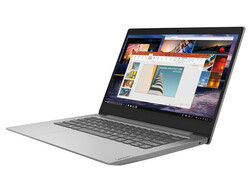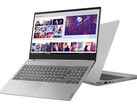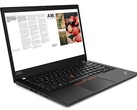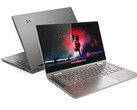Lenovo Ideapad Slim 1-14AST-05 Review: Chromebook Competitor Brings MS Office 365
Rating | Date | Model | Weight | Height | Size | Resolution | Price |
|---|---|---|---|---|---|---|---|
| 73.5 % v7 (old) | 02 / 2020 | Lenovo IdeaPad Slim 1-14AST-05 A6-9220e, Radeon R4 (Stoney Ridge) | 1.4 kg | 20.9 mm | 14.00" | 1920x1080 | |
| 79.9 % v7 (old) | 08 / 2019 | Medion Akoya E4253-30025387 Pentium N5000, UHD Graphics 605 | 1.4 kg | 15 mm | 14.00" | 1920x1080 | |
| 72.5 % v7 (old) | 06 / 2019 | Acer Aspire 1 A114-32-P0K1 Pentium N5000, UHD Graphics 605 | 1.7 kg | 17.95 mm | 14.00" | 1920x1080 | |
| 80.6 % v7 (old) | 01 / 2020 | Lenovo Chromebook S340-14T 81V30002GE Celeron N4000, UHD Graphics 600 | 1.4 kg | 18.8 mm | 14.00" | 1920x1080 |
Case, equipment and input devices - Plastic case for the Ideapad Slim
The plastic case is a light silver grey (Platinum Grey). Alternatively, the notebook is available in the colors red (Flame Orange) and blue (Ice Blue). Processing flaws are not noticeable. The base unit and lid should have a greater stiffness. The battery is firmly installed. There is no maintenance flap. You can get to the insides by removing the base unit.
The two type A USB ports work according to the USB 3.2 Gen 1 standard. An external screen can be connected via HDMI. There is an audio combo slot on the right side of the case. The built-in MicroSD memory card reader is one of the slow representatives of its kind. The stereo speakers produce an acceptable sound that lacks bass.
The WLAN chip (Qualcomm QCA9377) supports the standards 802.11 a/b/g/n/ac. The transmission speeds determined under optimal conditions (no other WLAN devices in the immediate vicinity, short distance between notebook and server PC) turn out mediocre.
The non-illuminated chiclet keyboard is suitable for carrying out regular typing tasks. The one-year MS Office 365 personal license included in the scope of delivery fits in well with this concept. Windows 10 Home in S mode serves as the operating system. A free upgrade to a "normal" Windows 10 can be made.
| SD Card Reader | |
| average JPG Copy Test (av. of 3 runs) | |
| Acer Aspire 1 A114-32-P0K1 (Toshiba Exceria Pro SDXC 64 GB UHS-II) | |
| Average of class Subnotebook (18.4 - 142, n=14, last 2 years) | |
| Lenovo Chromebook S340-14T 81V30002GE (Toshiba Exceria Pro M501 microSDXC 64GB) | |
| Lenovo IdeaPad Slim 1-14AST-05 (Toshiba Exceria Pro M501 microSDXC 64GB) | |
| maximum AS SSD Seq Read Test (1GB) | |
| Acer Aspire 1 A114-32-P0K1 (Toshiba Exceria Pro SDXC 64 GB UHS-II) | |
| Average of class Subnotebook (22.5 - 207, n=14, last 2 years) | |
| Medion Akoya E4253-30025387 (Toshiba Exceria Pro M501 microSDXC 64GB) | |
| Lenovo IdeaPad Slim 1-14AST-05 (Toshiba Exceria Pro M501 microSDXC 64GB) | |
| Networking | |
| iperf3 transmit AX12 | |
| Medion Akoya E4253-30025387 | |
| Lenovo IdeaPad Slim 1-14AST-05 | |
| Acer Aspire 1 A114-32-P0K1 | |
| iperf3 receive AX12 | |
| Medion Akoya E4253-30025387 | |
| Acer Aspire 1 A114-32-P0K1 | |
| Lenovo IdeaPad Slim 1-14AST-05 | |
Display - A TN panel for the Lenovo computer
The brightness (226.4 cd/m²) and contrast (551:1) of the matt, unstable 14-inch Full HD screen with an unstable viewing angle are too low. Compared to the notebook's price level, the values are acceptable. The display shows a flickering with a frequency of 147 Hz at brightness levels of 60 percent and below.
The color deviation is clearly above the target with a value of just under 11 (Delta-E less than 3). The display also suffers from a clear blue cast. By calibrating the screen, the color deviation drops to just under 5.5, the blue cast disappears and the gray levels are displayed in a much more balanced way. The screen cannot display the color spaces AdobeRGB (39 percent) and sRGB (62 percent).
| |||||||||||||||||||||||||
Brightness Distribution: 86 %
Center on Battery: 245 cd/m²
Contrast: 551:1 (Black: 0.445 cd/m²)
ΔE ColorChecker Calman: 10.75 | ∀{0.5-29.43 Ø4.81}
calibrated: 5.48
ΔE Greyscale Calman: 12.85 | ∀{0.09-98 Ø5.1}
62% sRGB (Argyll 1.6.3 3D)
39% AdobeRGB 1998 (Argyll 1.6.3 3D)
42.54% AdobeRGB 1998 (Argyll 3D)
61.8% sRGB (Argyll 3D)
41.15% Display P3 (Argyll 3D)
Gamma: 2.42
CCT: 15973 K
| Lenovo IdeaPad Slim 1-14AST-05 TN LED, 1920x1080, 14" | Medion Akoya E4253-30025387 IPS, 1920x1080, 14" | Acer Aspire 1 A114-32-P0K1 TN LED, 1920x1080, 14" | Lenovo Chromebook S340-14T 81V30002GE IPS, 1920x1080, 14" | |
|---|---|---|---|---|
| Display | -0% | -2% | ||
| Display P3 Coverage (%) | 41.15 | 40.96 0% | 40.35 -2% | |
| sRGB Coverage (%) | 61.8 | 61.1 -1% | 60.3 -2% | |
| AdobeRGB 1998 Coverage (%) | 42.54 | 42.37 0% | 41.71 -2% | |
| Response Times | -48% | 5% | -63% | |
| Response Time Grey 50% / Grey 80% * (ms) | 44 ? | 42 ? 5% | 43 ? 2% | 46 ? -5% |
| Response Time Black / White * (ms) | 14 ? | 28 ? -100% | 13 ? 7% | 31 ? -121% |
| PWM Frequency (Hz) | 147 ? | 24500 ? | 250 ? | |
| Screen | 15% | -3% | 25% | |
| Brightness middle (cd/m²) | 245 | 262 7% | 208 -15% | 248 1% |
| Brightness (cd/m²) | 226 | 242 7% | 192 -15% | 237 5% |
| Brightness Distribution (%) | 86 | 87 1% | 85 -1% | 85 -1% |
| Black Level * (cd/m²) | 0.445 | 0.505 -13% | 0.41 8% | 0.31 30% |
| Contrast (:1) | 551 | 519 -6% | 507 -8% | 800 45% |
| Colorchecker dE 2000 * | 10.75 | 5.49 49% | 10.1 6% | |
| Colorchecker dE 2000 max. * | 20.82 | 10.63 49% | 28.85 -39% | |
| Colorchecker dE 2000 calibrated * | 5.48 | 4.38 20% | ||
| Greyscale dE 2000 * | 12.85 | 4.84 62% | 10.96 15% | 3.58 72% |
| Gamma | 2.42 91% | 2.3 96% | 2.24 98% | 2.17 101% |
| CCT | 15973 41% | 6347 102% | 11669 56% | 6697 97% |
| Color Space (Percent of AdobeRGB 1998) (%) | 39 | 39 0% | 38 -3% | |
| Color Space (Percent of sRGB) (%) | 62 | 61 -2% | 59 -5% | |
| Total Average (Program / Settings) | -11% /
4% | 0% /
-2% | -19% /
3% |
* ... smaller is better
Display Response Times
| ↔ Response Time Black to White | ||
|---|---|---|
| 14 ms ... rise ↗ and fall ↘ combined | ↗ 10 ms rise | |
| ↘ 4 ms fall | ||
| The screen shows good response rates in our tests, but may be too slow for competitive gamers. In comparison, all tested devices range from 0.1 (minimum) to 240 (maximum) ms. » 33 % of all devices are better. This means that the measured response time is better than the average of all tested devices (20.4 ms). | ||
| ↔ Response Time 50% Grey to 80% Grey | ||
| 44 ms ... rise ↗ and fall ↘ combined | ↗ 24 ms rise | |
| ↘ 20 ms fall | ||
| The screen shows slow response rates in our tests and will be unsatisfactory for gamers. In comparison, all tested devices range from 0.165 (minimum) to 636 (maximum) ms. » 72 % of all devices are better. This means that the measured response time is worse than the average of all tested devices (31.9 ms). | ||
Screen Flickering / PWM (Pulse-Width Modulation)
| Screen flickering / PWM detected | 147 Hz | ≤ 60 % brightness setting | |
The display backlight flickers at 147 Hz (worst case, e.g., utilizing PWM) Flickering detected at a brightness setting of 60 % and below. There should be no flickering or PWM above this brightness setting. The frequency of 147 Hz is very low, so the flickering may cause eyestrain and headaches after extended use. In comparison: 53 % of all tested devices do not use PWM to dim the display. If PWM was detected, an average of 8255 (minimum: 5 - maximum: 343500) Hz was measured. | |||
Performance, emissions and battery life - The Slim 1 has weak hardware
Lenovo equips the Ideapad with a weak APU, 4 GB of RAM (hard-soldered, no memory banks) and eMMC memory. The notebook reaches its limits very quickly. Loading and starting processes are delayed. The notebook always reacts sluggishly. The device should not be expected to run more than one open application or website at a time.
The weak-breasted AMD APU is called A6-9220e (2 CPU cores, 2 threads; Radeon R4 GPU; Stoney Ridge). This slower clocked variant of the regular A6-9220 APU is passively cooled. The Cinebench R15 loop test reveals that the CPU part of the APU can only operate at high speed for a short time. The performance is already halved in the second run. The APU is on a performance level with Intel's Atom processors of past years.
The transfer rates of the eMMC module remain significantly below today's capabilities. The comparison with the eMMC memory of the Acer Aspire 1 A114-32 shows what would be feasible. Lenovo has trimmed our test device in order to be able to install the option of an M.2 SSD (see picture above). A pity. It would have given owners the opportunity to drive out some of the system's inertia. Even the cheapest SSD reacts more lively than the eMMC memory. Moreover, the memory space (about 33 GB after the initial setup) could have been expanded. All that remains is an expansion via MicroSD card.
The Slim 1 works silently, hardly warms up and is satisfied with little energy. The Lenovo computer doesn't belong to the long-runners. It ends our practical WLAN test (simulates the load when calling up websites with a script) after 5:39 h - we would have expected more here.
Cinebench R15 Loop
| Lenovo IdeaPad Slim 1-14AST-05 64 GB eMMC Flash | Medion Akoya E4253-30025387 64 GB eMMC Flash | Chuwi LapBook Pro 64 GB eMMC Flash | Acer Aspire 1 A114-32-P0K1 64 GB eMMC Flash | Average 64 GB eMMC Flash | Average of class Subnotebook | |
|---|---|---|---|---|---|---|
| CrystalDiskMark 5.2 / 6 | 61% | 118% | 215% | 156% | 4898% | |
| Write 4K (MB/s) | 4.58 | 6.435 41% | 13.46 194% | 24.08 426% | 16 ? 249% | 146.2 ? 3092% |
| Read 4K (MB/s) | 7.106 | 5.91 -17% | 7.071 0% | 11.48 62% | 11 ? 55% | 63.3 ? 791% |
| Write Seq (MB/s) | 37.33 | 66.7 79% | 105.3 182% | 149.7 301% | 109 ? 192% | 2442 ? 6442% |
| Read Seq (MB/s) | 143 | 268.9 88% | 235.5 65% | 271.2 90% | 207 ? 45% | 3060 ? 2040% |
| Write 4K Q32T1 (MB/s) | 5.623 | 7.795 39% | 14.68 161% | 23.87 325% | 22.4 ? 298% | 415 ? 7280% |
| Read 4K Q32T1 (MB/s) | 9.663 | 22.76 136% | 24.31 152% | 30.76 218% | 31.5 ? 226% | 481 ? 4878% |
| Write Seq Q32T1 (MB/s) | 41.03 | 83 102% | 114.2 178% | 137.2 234% | 104.6 ? 155% | 4328 ? 10448% |
| Read Seq Q32T1 (MB/s) | 128.3 | 150 17% | 140.7 10% | 205.1 60% | 166.5 ? 30% | 5537 ? 4216% |
| low | med. | high | ultra | |
|---|---|---|---|---|
| BioShock Infinite (2013) | 18.5 | 8.6 | 7.4 | 3.7 |
Temperature
(+) The maximum temperature on the upper side is 32.8 °C / 91 F, compared to the average of 35.9 °C / 97 F, ranging from 21.4 to 59 °C for the class Subnotebook.
(+) The bottom heats up to a maximum of 34.9 °C / 95 F, compared to the average of 39.3 °C / 103 F
(+) In idle usage, the average temperature for the upper side is 25.8 °C / 78 F, compared to the device average of 30.8 °C / 87 F.
(+) The palmrests and touchpad are cooler than skin temperature with a maximum of 27.6 °C / 81.7 F and are therefore cool to the touch.
(±) The average temperature of the palmrest area of similar devices was 28.2 °C / 82.8 F (+0.6 °C / 1.1 F).
Speakers
Lenovo IdeaPad Slim 1-14AST-05 audio analysis
(-) | not very loud speakers (69.1 dB)
Bass 100 - 315 Hz
(-) | nearly no bass - on average 19.2% lower than median
(±) | linearity of bass is average (13.1% delta to prev. frequency)
Mids 400 - 2000 Hz
(±) | higher mids - on average 7% higher than median
(±) | linearity of mids is average (8.8% delta to prev. frequency)
Highs 2 - 16 kHz
(+) | balanced highs - only 4.9% away from median
(±) | linearity of highs is average (9.6% delta to prev. frequency)
Overall 100 - 16.000 Hz
(±) | linearity of overall sound is average (25.8% difference to median)
Compared to same class
» 85% of all tested devices in this class were better, 3% similar, 12% worse
» The best had a delta of 5%, average was 19%, worst was 53%
Compared to all devices tested
» 78% of all tested devices were better, 5% similar, 17% worse
» The best had a delta of 4%, average was 24%, worst was 134%
Energy consumption
| Off / Standby | |
| Idle | |
| Load |
|
Key:
min: | |
Battery life
Pros
Cons
Verdict
Even if the price (280 Euro) seems tempting, the possible purchase of the computer should be well considered. The notebook quickly reaches its limits and basically reacts sluggishly. There's also no way to speed up the system in any way.
The Ideapad Slim 1-14AST-05 doesn't cut a convincing figure as a Chromebook competitor. Chromebooks generally work more agile - even models with weak hardware.
Lenovo has decided on a combination of a weak APU, 4 GB RAM and eMMC module, which is somewhat overtaxed with Windows 10. The device should only be used for one open application or website at the most. The display is from the bottom shelf - dark, low-contrast, unstable viewing angle are the keywords here. There is not much storage space available (approx. 33 GB after initial setup). Lenovo denies our test device the possibility to install an SSD. Only a memory expansion via a MicroSD card remains.
A few positive things can be said, though. Lenovo grants the Ideapad a two-year warranty. The non-illuminated chiclet keyboard has made a good impression and is also suitable for doing regular typing work. A one-year MS Office 365 personal license worth almost 70 euro is also included.
Thus, the Ideapad offers itself as an affordable typewriter for pupils and students. However, it lacks endurance. The Ideapad ends our practical WLAN test (simulates the load when calling up web pages with a script) after 5:39 h - too little for a day at school or university. Here, the power supply unit would always have to be carried along.
Lenovo IdeaPad Slim 1-14AST-05
- 02/17/2020 v7 (old)
Sascha Mölck





